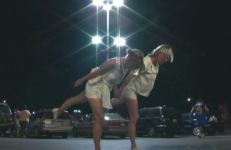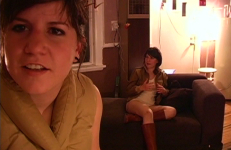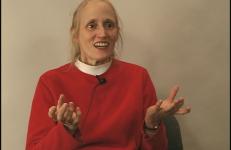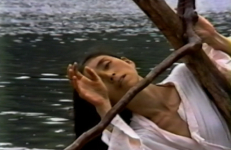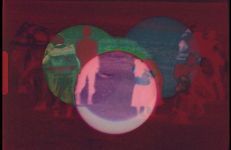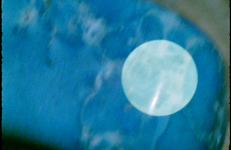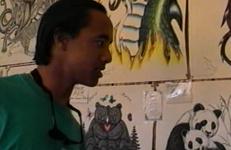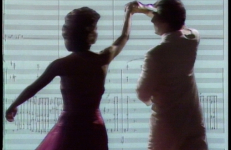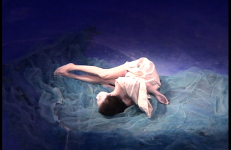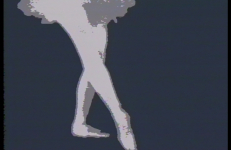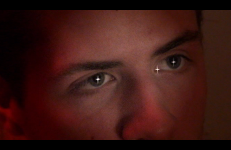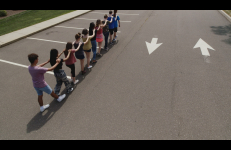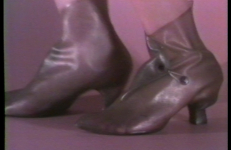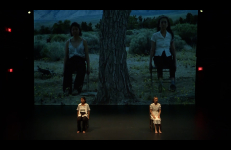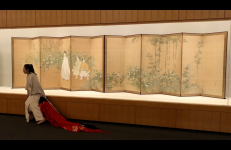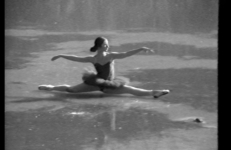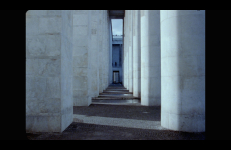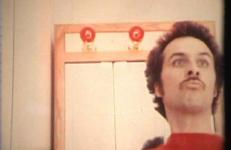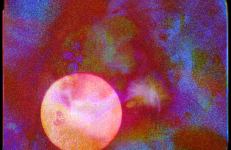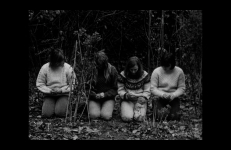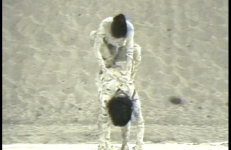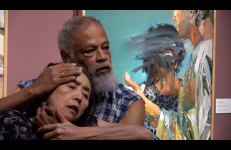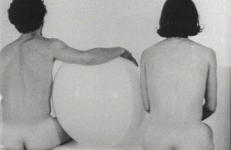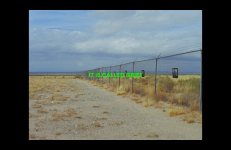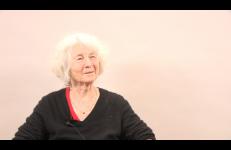C.L.U.E. (color location ultimate experience), Part 1 is a collaborative video and performance work by artists A.L. Steiner and robbinschilds, with AJ Blandford and Seattle-based band Kinski. Inhabiting the intersection of human movement and architecture, A.L. Steiner and robbinschilds (Sonya Robbins and Layla Childs) present a full-spectrum video, set to a score by rock quartet Kinski.
Dance
Compromise is Episode 1 of the video art trilogy, This is More Than Love I Feel Inside, in which Jillian Peña traces a queer relationship from inception to demise.
In this interview American filmmaker, poet, and lyricist, Cecelia Condit gives shape to the contours of her work process. The artist describes the influence of her relationship with her mother, her long-term investment in the macabre, and her ongoing desire to confront death through art. While covering a broad range of topics, Condit’s discussion of her work and interests returns to several defining themes: aging, grotesqueness, and the notion of movement, both in terms of her own past as a dancer and the notion of the body in decay. With a particular emphasis on the production and context of her videos, Annie Lloyd (2008), and All About a Girl (2004), this interview offers insight into the artist’s fascination with aging, sweetness, and storytelling, while also articulating her joyful sense of discovery within the art-making process. No longer working with scripts, Condit presents herself in the interview as a scavenger–much like the crows she incorporates into her work–assembling videos which straddle the line between strange and silly. – Faye Gleisser
Eiko & Koma created Dancing in Water: the Making of River as the first video work for the Retrospective Project. Often produced in collaboration with environmental groups and park officials, River is an outdoor work Eiko & Koma performed in nine different sites. River usually takes place in a body of moving water, and the journey downstream suggests the passage of life and time. This video follows Eiko & Koma from rehearsals in the Catskills to performances in the Delaware River and the American Dance Festival.
In Danza Solar, Super8 archival footage of dancers is superimposed with 16mm views of the sun (suns). The film evokes a communal solar trance, both Andean and Mesoamerican. Part of a collection of works the collective considers "Shamanic Materialism," Danza Solar is a Mesoamerican spell unleashed.
A brief glimpse into the cycles of Coyolxauhqui, the moon goddess, whose cycles used to be a dance. A fast-paced jazz soundtrack accompanies the quick, darting movements of the moon.
This title is only available on Kip Fulbeck Selected Videos: Volume One.
A portrait of influential Dutch musician and composer Louis Andriessen, as he talks about composing a new work. Andriessen draws inspiration from the life of Dutch painter Piet Mondrian and his love for ballroom dancing.
Co-commissioned by the Dance Center of Columbia College Chicago and Danspace Project, Death Poem is a meditation on dying. Eiko dances a long solo on a futon under a mosquito net, accompanied by the sound of insects and cicadas. Koma enters from another world and tries to bring Eiko back with him, but he leaves without her, as she is not yet ready to go.
In Deux Pieds, video is used to create dance illusions, effects impossible to achieve in dance except via video technology. Video “keying” (a process of dividing areas of a black and white image into percentages of gradation) and blending of two separate images is used to enable Laurie’s legs to move independently of each other. Against a black background, she wears a black stocking on one leg, effectively “erasing” the leg to the camera’s eye, then switches the stocking to the other leg, and the two images are mixed together.
Lips that issue forth melodious vows. Warm skin on bedsheets stained with dreams. Faces crowned with halos that light a path to temples of the soul…..You will find it here in DREAMS and OMENS!
This title comprises Wishful Thinking (2015), Testimony (2013), and New Beginnings (2014) which were compiled into this form by Mike Kuchar in 2022.
Drills is a film about the choreography of preparing for the future. A hybrid documentary and experimental dance film reimagining the form of the Cold War-era, US government-produced social guidance film, Drills asks what futures we are preparing for through the exercises embodying present anxieties. Weaving in between multiple forms of choreography and documentation, Drills restages lockdown and active shooter drills, frames corporate and tech start-up office meditation, and reperforms Boy Scout drills from the 1917 Boy Scout manual.
Duet for Tap and Galoshes is a visual restructuring of a real time tap performance, presented in two parts. In part one, Laurie’s feet fill the television screen, and different close-ups of the feet are edited to the beats of the tap rhythms, creating a quickly paced montage of sound and image seen from different points of view. In part two, Laurie substitutes tap shoes for a pair of semi-translucent galoshes to show the workings of her bare feet, visible through the galoshes.
The Duet Project: Distance is Malleable is a mutable and evolving series of experiments in collaboration. Negotiating differences of race, time, culture, ethnicity, religion and gender, the artists seek to maximize the potentials of their encounters.
Eiko's grandfather Chikuha Otake (1878–1936) was a praised figure in traditional Japanese painting. But his anti-mainstream sentiments were shunned by the field authorities. His reputation was severely damaged by his failed run for the House of Representatives. Filmed in 2018, at the Philadelphia Museum of Art and the Suiboku Museum in Toyama, Japan, Eiko's edit combines videos of Chikuha's paintings and Eiko's performance with quotes from his essays and Eiko's musings.
Special thank you to David Brick, Ryohei Endo, Hiroyuku Horikawa, Feliece Fischer, and John Killacky.
The Dying Swan is a recreation of the acclaimed ballet — Russian ballerina Anna Pavlova's most famous role — borrowed from its theatrical context and taken back to the lake. A frozen pond and fifteen-degree weather is the stage and setting for this version of the ballet, and the dancer (Laurie McDonald) in traditional costume of pointe shoes and tutu performs the death throes of the swan on the ice. The music is from "Carnival of the Animals" by Camille Saint-Saens.
Assisted by Alan Powell.
E42 is a cinematic exploration of the area in Rome knows as the EUR, a modernist landscape that was originally designated by Mussolini as the the site of the World Fair of 1942 and as a celebration of the 20 year anniversary of Fascism. Originally designed as a monumental space for public performance and collective acts of solidarity to the Fascist regime, this landscape was in fact never inaugurated.
"A refreshing look at karaoke, psychedelic dance moves, and donuts all mashed together into a small and swinging film about a man who considers his private thoughts and private jokes worth sharing with a large audience. And it's unlikely that many would disagree."
--Impakt Festival, Utrecht, The Netherlands, 2001
This title is also available on Jim Finn Videoworks: Volume 1.
In the nest of the sun, Xolotl, Huitzilin and Xochitl meet to recover the dance of radiation, whose colorful heat stirs the new fire of their cosmic dance. Part of the Film Tonalli.
Elle is an experimental dance film shot in a semi industrial landscape in Brooklyn reflecting on every day movements of falling and getting up.
Cinematography: Carolyn MaCartney
Choreography: Eleanor Hullihan and Katy Pyle Dancers, Eleanor Hullihan, Katy Pyle, Beth Gill, Emily Wexler Music, Zeena Parkins
Editor: Geoffrey Pugen
Event Fission is an outdoor performance on the Hudson River landfill, produced by Creative Time. Eiko & Koma danced with a huge white flag billowing on top of a sand dune as the audience watched from below. The white flag was used to symbolically attack the newly developed downtown buildings. On a lower level of the landfill, to which Eiko & Koma tumbled down, there were fires on four corners of the performing area. At the end of the performance of 50 minutes, Eiko & Koma were swallowed into a deep hole they had dug and hid, disappearing with a blast of sand.
In collaboration with Ishmael Houston-Jones.
On September 1, 2022, Eiko and Ishmael Houston-Jones performed in Beverly McIver's painting exhibition Full Circle, curated by Kim Boganey.
The whole event took place in connected galleries of her show, but this excerpt is when Ishmael and Eiko danced a duet in front of the paintings that were also a duet of a sort.
Camera by Julie Ganas.
Edited by Eiko Otake.
A compilation of five early short films made between 1966 to 1969.
Hand Movie 1966, 6:00, b&w, silent, 8mm
Close-up of a hand, the fingers of which enact a sensuous dance. Camerawork by William Davis.
Volleyball (Foot Film) 1967, 10:00 b&w, silent, 16mm
A volleyball is rolled into the frame and comes to rest. Two legs in sneakers, seen from the knees down, enter the frame and stand beside it. Cut to new angle, same characters and actions. Camerawork by Bud Wirtschafter.
Flowers for LH reflects on the last play written by Lorraine Hansberry entitled What Use Are Flowers?
Dance: Joey Kipp
Cinematography: Steve Cossman, Cynthia Madansky
Music: Zeena Parkins
The later 1950s and early 1960s saw the development and proliferation of radically new forms of dance driven by a desire to understand the essentiality of movement divorced from traditional, balletic and modern syntaxes. At the forefront of this new wave of performance was Simone Forti, an artist with a hand in both improvisational techniques and choreographed task-maneuvers. This interview details her exploration of each – with a particular focus on her earliest investigations into movement, owing to time spent under the study of Anna Halprin.




